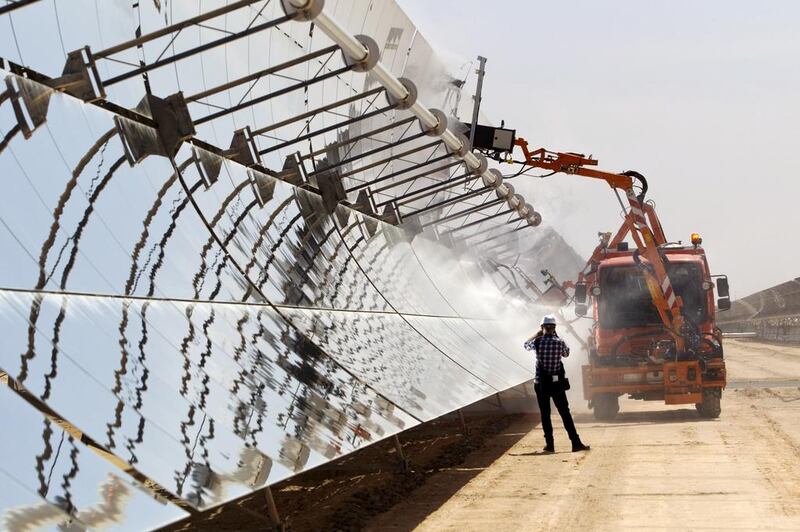The power of the sun and wind provides an opportunity for infinite energy, but how can it be harnessed? It is a problem that continues to confound scientists who are working to make such power sources viable.
As everyone knows, renewable energy is big business in the UAE.
Not only is Abu Dhabi home to the headquarters of the International Renewable Energy Agency or Irena, the country’s solar-power sector is also growing fast.
This year, it was predicted that the industry would add 1,000 jobs over the coming two years, with the growth in projects – from household scale upwards – helped along by the country’s abundant supply of sunshine.
But despite the growing interest in renewables here and elsewhere, a major difficulty remains in how to store the electricity the sector generates for the times when it is needed most.
Unlike, say, coal-fired power stations, solar and wind farms cannot simply be switched on at times of greatest demand. The elements decide the levels of power that can be generated.
One solution now being employed involves redox flow batteries (RFBs) that make use of the element vanadium (VRFBs). These can be used to convert electrical energy into chemical energy, which then can be turned back into electricity when needed. But there are downsides to this, with cost being the most notable.
“There are several VRFB installations that have been deployed worldwide in the hundreds and thousands of kilowatts,” says Dr Saif Al Mheiri, an assistant professor of mechanical and materials engineering at the Masdar Institute of Science and Technology.
“However, the technology still needs further improvement in order to achieve its maximum potential.”
VRFBs make use of the fact that vanadium, which occurs naturally in dozens of minerals, can exist in several oxidation states when dissolved in solution.
The oxidation state reflects the number of electrons, or negatively charged subatomic particles, associated with each vanadium particle.
A VRFB consists of two tanks separated by a membrane, with each tank containing vanadium in solution in two oxidation states. The battery’s chemical energy is discharged and turned into electricity when, on each side, pumps force the liquids past electrodes.
On one side of the battery the vanadium releases electrons, and on the other it accepts them. Protons move across the battery’s membrane to balance out the movement of electrons.
Charging the battery involves the opposite process. Having vanadium on both sides of the battery eliminates the risk of contamination across the membrane. In batteries using two different elements, such contamination can lead to a loss of performance.
Studies have indicated, Dr Al Mheiri notes, that the economic case for using batteries to store electricity is stronger when the power is generated from the sun rather than wind. This makes it appropriate that, as a researcher in a country with no lack of sunshine, he is trying to develop better, more efficient versions of these batteries.
“We need to improve the low-energy density of VRFBs by improving the solubility and the stability of the vanadium species (the active metal in these batteries,” he says.
“Another limit is that these batteries, for now, are only operational between 10°C to 40°C. This requires innovative thermal management solutions in hot and cold climates.”
Dr Al Mheiri, an Emirati with bachelor’s, master’s and doctoral degrees from US universities, is carrying out his research in collaboration with Massachusetts Institute of Technology scientists.
Improvements in battery technology are especially sought after because the need to store electricity is only going to increase.
Peter Taylor, a professor of sustainable energy systems at the Centre for Integrated Energy Research at the University of Leeds, says an inability to store power is less of a problem when renewables account for a small percentage of total energy production.
Other more flexible power sources, such as coal, can make up any shortfall. But when they form a higher percentage of total production – some experts have put the figure at about 30 per cent of total capacity – this changes.
As Dr Tim Mays, head of the department of chemical engineering at Bath University , puts it, “a mismatch between supply and demand” develops.
“As you increase the penetration of renewables into electricity grids, you’re no longer able to accommodate intermittency,” he says.
There are alternatives to storage, such as using large interconnectors to transfer power between countries. This can smooth out the fluctuations in generation capacity.
“But storage is one of the key options and, in many circumstances, it might be easier,” says Prof Taylor.
While Dr Al Mheiri is looking into vanadium-based batteries, there are alternatives.
A report last year from Lux Research, Flow Battery Cost Reduction: Exploring Strategies to Improve Market Adoption, noted that the use of flow batteries commercially “is still in the early stages”, and although vanadium is most often used, “the most competitive systems may eventually come from electrolytes that are currently at lab scale today”.
Geoffrey Heal, the Donald C Waite III professor of social enterprise at Columbia Business School, says it is too early to say that storage technologies will dominate.
“I suspect there will be several and that utilities, which need to store hundreds of megawatt hours, will use different technologies from households, who only need a few kilowatt hours,” says Prof Heal, who teaches about energy markets and has written 18 books.
“The former may use flow batteries, the latter conventional lithium ion batteries or their replacements. It is also possible that hydrogen will emerge as an energy-storage vehicle.”
There could be greater use of combined forms of storage, such as supercapacitors – devices that can deliver electrical energy at a very high rate – used along with batteries to allow faster charging and discharging.
“If you can develop different types of hybrid systems, that would be good as it will result in devices that have more advantages and fewer weaknesses compared to standalone storage technologies,” Prof Taylor says.
Whatever the future holds, it is likely to involve VRFBs. Dr Al Mheiri is identifying the mixtures of solvents that perform best, with “binary mixtures” of two solvents offering promising results. He is also focused on improving the electrodes.
“At a later stage, we plan to put everything together – the binary solvent mixtures and the enhanced electrodes – in a real battery cell to simulate the actual conditions of an operating battery,” he says.
“If everything moves according to plan we will connect these small battery cells together to make a stack. A stack is the basis for any industrial-scale battery.”
So as the solar – and wind – industries begin to shine, the batteries needed to make these sources of power viable are going to become ever more efficient.
newsdesk@thenational.ae
Daniel Bardsley is a freelance journalist in the UK and a former reporter at The National. He has science degrees from the University of Oxford and the University of East Anglia.






